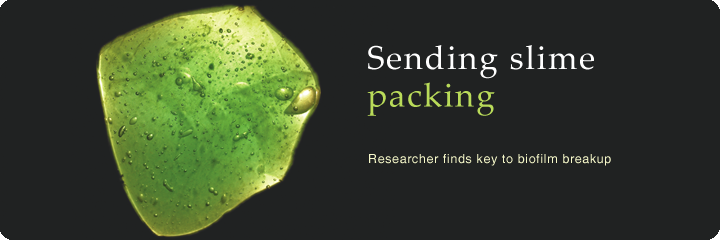
David Davies has discovered and is synthesizing a molecule that could help put one of the most virulent “terrorist cells“ in all of nature out of business.
Biofilms are complex aggregations of bacteria marked by the excretion of a protective and adhesive matrix, which is why these bacterial colonies are commonly referred to as slime.
Davies, an associate professor of biology at Binghamton University, has isolated a compound that will cause biofilm colonies to disperse, thus leaving individual bacteria up to 1,000 times more susceptible to disinfectants, antibiotics and immune functions. The discovery will likely mean a sea change in health care, manufacturing, shipping and pharmaceutics over the coming years. It will most certainly drive worldwide biofilm research in new directions.
The small molecule Davies is working with appears to be one of the few known examples anywhere in nature of a communication signal that remains effective across species, family and phyla. In fact, though the evidence isn’t yet in on that, Davies predicts the compound may also prove to have communicative effect even across bacterial kingdoms.
“I consider this the Holy Grail of research in biofilms,“ he said. “It’s a new paradigm in the way we look at how bacteria regulate their behavior.“
Davies’ prominence in his field was already secured when he showed in the late 1990s that bacteria "talk to one another“ through cell-to-cell communication and that such signaling is key to biofilm formation. Davies discovered the molecular medium of that communication in Pseudomonas aeruginosa, a biofilm-forming microorganism that is arguably the most common organism on the planet.
Since that time, building on Davies’ work, others in the field have characterized two other molecular signals, or autoinducers, that are key to various phases of bacterial development cycles either within a particular bacterial species or across species.
The dispersion autoinducer Davies is now investigating has shown itself to be effective in dispersing biofilms containing Pseudomonas aeruginosa, Streptococcus mutans (strep), Escherichia coli (E. coli) and Staphylococcus aureus (staph) whether those bacteria exist in a pure or mixed-culture biofilm.
“We’ve also tested it on undefined mixed cultures that we just got from the air and the water in the lab, and it worked on that, too,“ he said.
The dispersion-inducing molecule provokes genetic and physiological changes in the biofilm bacteria, causing them to disperse and return to a planktonic state. In lay terms, Davies has discovered at the very least how to tell four of the most problematic organisms around to pack up and get out of Dodge. And in so doing, the bacteria become easier to kill than the average mosquito.
“There have been a lot of people working on finding a dispersion autoinducer, and it’s been a very tricky thing to nail down,“ Davies said of his most recent breakthrough.
“But we now have a way of isolating and purifying the compound, and we should soon be able to synthesize it so we can make it in higher concentrations.“
Ask any bacteria. There is strength - not to mention mischief and worse - to be found in community. And Davies’ discovery of the naturally occurring molecule that signals them to forsake the security of a biofilm and disperse is decidedly bad news for them. That’s because, although when traveling alone in planktonic form they are of small consequence and generally easy to manage even with antibacterial hand soaps, when they form biofilms, bacteria seem to gain super powers.
And just like super villains unable to control their nefarious urges, biofilms are more often than not up to no good from a human perspective. Biofilms develop almost anywhere that water and solids, or solids and gases, meet, which means they are virtually everywhere. They are formed when individual microorganisms embed themselves in a gelatinous structure of their own making, so in human terms the characteristic “slime“ of biofilms, which comprises organic polymers that can grow to several centimeters thick and cover large areas, spells all kinds of big trouble.
page 1 | page 2